Equivalence class formation in a trace stimulus pairing two-response format: effects of response labels and prior programmed transitivity induction
- PMID: 20119522
- PMCID: PMC2707141
- DOI: 10.1901/jeab.2009.92-57
Equivalence class formation in a trace stimulus pairing two-response format: effects of response labels and prior programmed transitivity induction
Abstract
Three experiments identified factors that did and did not enhance the formation of two-node four-member equivalence classes when training and testing were conducted with trials presented in a trace stimulus pairing two-response (SP2R) format. All trials contained two separately presented stimuli. Half of the trials, called within-class trials, contained stimuli from the same class while the other half, called cross class trials, contained stimuli from different classes. On within class trials, making a YES response was correct and making a NO response was wrong. On cross class trials, making a NO response was correct and making a YES response was wrong. In Experiment 1, similar intermediate percentages of participants (about 50%) formed classes, regardless of whether the responses were labeled YES and NO or SAME and DIFF. Response labeling thus did not influence class formation. Regardless of response labels, failures of class formation were primarily due to failure of class-indicative responding produced by within-class transitivity probes. In Experiment 2, only 50% of participants formed classes without prior training, as in Experiment 1, but 100% of participants formed equivalence classes after the establishment of a generalized transitivity repertoire by use of a programmed transitivity induction protocol. Experiment 3 examined two components of the programmed transitivity induction protocol and found that the exclusion of AC trials had no effect on the percentage of participants who formed equivalence classes, while presenting the stimulus sets in randomized order interfered with equivalence class formation. A further analysis found that a number of stimulus control topographies differentiated between individuals who did and did not form equivalence classes. In general, then, these experiments demonstrate that equivalence classes can be formed reliably when training and testing are conducted in an SP2R format, supporting the view that equivalence class formation can account for the development of conceptual categories in natural settings.
Keywords: college students; equivalence classes; generalized transitivity repertoire; keyboarding; successive matching trial format; trace stimulus-pairing two-response trial format.
Figures
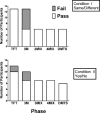
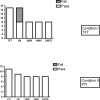
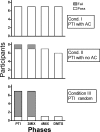
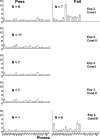
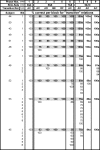
Similar articles
-
Nodal structure and stimulus relatedness in equivalence classes: post-class formation preference tests.J Exp Anal Behav. 2011 May;95(3):343-68. doi: 10.1901/jeab.2011.95-343. J Exp Anal Behav. 2011. PMID: 21547071 Free PMC article.
-
Nodal structure and the partitioning of equivalence classes.J Exp Anal Behav. 2008 May;89(3):359-81. doi: 10.1901/jeab.2008-89-359. J Exp Anal Behav. 2008. PMID: 18540220 Free PMC article.
-
Formation of new stimulus equivalence classes by exclusion.J Exp Anal Behav. 2018 Mar;109(2):380-393. doi: 10.1002/jeab.322. Epub 2018 Mar 6. J Exp Anal Behav. 2018. PMID: 29509271
-
Associative concept learning in animals.J Exp Anal Behav. 2014 Jan;101(1):130-51. doi: 10.1002/jeab.55. Epub 2013 Oct 29. J Exp Anal Behav. 2014. PMID: 24170540 Free PMC article. Review.
-
A Review of Backward Higher-Order Conditioning: Implications for a Pavlovian Conditioning Analysis of Stimulus Equivalence.Perspect Behav Sci. 2023 Jul 20;46(3-4):493-514. doi: 10.1007/s40614-023-00385-y. eCollection 2023 Dec. Perspect Behav Sci. 2023. PMID: 38144547 Free PMC article. Review.
Cited by
-
Computational Simulation of Equivalence Class Formation Using the go/no-go Procedure with Compound Stimuli.Psychol Rec. 2016;66:439-449. doi: 10.1007/s40732-016-0184-1. Epub 2016 May 19. Psychol Rec. 2016. PMID: 27512235 Free PMC article.
-
Transitive and anti-transitive emergent relations in pigeons: support for a theory of stimulus-class formation.Behav Processes. 2015 Mar;112:49-60. doi: 10.1016/j.beproc.2014.07.006. Epub 2014 Jul 19. Behav Processes. 2015. PMID: 25050907 Free PMC article.
-
Relational discrimination by pigeons in a go/no-go procedure with compound stimuli: a methodological note.J Exp Anal Behav. 2011 Nov;96(3):417-26. doi: 10.1901/jeab.2011.96-413. J Exp Anal Behav. 2011. PMID: 22084498 Free PMC article.
-
Derived relational responding: a comparison of match-to-sample and the relational completion procedure.J Exp Anal Behav. 2010 Jul;94(1):37-55. doi: 10.1901/jeab.2010.94-37. J Exp Anal Behav. 2010. PMID: 21279161 Free PMC article.
References
-
- Adams B.J, Fields L, Verhave T. The effects of test order on intersubject variability during equivalence class formation. The Psychological Record. 1993;43:133–152.
-
- Adams B.J, Fields L, Verhave T. Effects of unreinforced conditional selection training, and feedback on equivalence class formation. The Psychological Record. 1999;49:685–702.
-
- Arntzen E. Probability of equivalence formation: Familiar stimuli and training sequence. The Psychological Record. 2004;54:275–291.
-
- Buffington D.M, Fields L, Adams B.J. Enhancing the formation of equivalence classes by pretraining of other equivalence classes. The Psychological Record. 1997;47:1–20.
Publication types
MeSH terms
LinkOut - more resources
Full Text Sources

